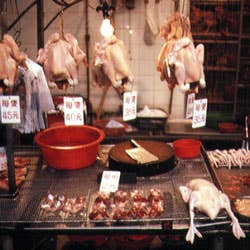
How Hong Kong Cooks
Kitchens in the crown colony tend to be like everything else in this space-starved city—tiny. The stove is usually a small gas model, often with four concentric gas rings per burner to generate the heat necessary for stir-frying. The refrigerator is sometimes located in another room entirely.
Wherever it is, the refrigerator is likely to contain bean curd, sliced ginger (in dry sherry or rice wine), and perhaps preserved ginger shoots or pickled mustard greens. Most food is bought fresh daily. A few long-lasting staples have a permanent place in the Hong Kong larder—a burlap bag of long-grain rice, weighing anything from 25 to 200 pounds; peanut oil, favored for stir-frying because of its neutral flavor and high burning point; and a large jug of soy sauce. There might also be sesame oil, rice wine, hoisin sauce, and fish sauce—the last of these a relatively recent addition to local cooking.
In a cupboard will be cornstarch for thickening sauces, a small clay pot with holes to hold garlic, and a tin of five-spice powder (a blend of cinnamon, Sichuan peppercorn, cloves, fennel seed, and star anise). Dried oysters, shrimp, and mushrooms are also likely to be found.
The essential implements are a lidded wok, chopsticks, handled strainers, a steamer or two (either bamboo or a more elaborate clay model from Hunan), a long-handled metal spatula, the lightweight clay pots known as sand pots, an assortment of cleavers, and a wood chopping block. Almost everything can be hung on hooks, freeing scarce counter space.
In all but the poorest of today's Hong Kong kitchens, there is one other essential item: an electric rice cooker. After 5,000 years of cooking rice without such aids, the Chinese appreciate a foolproof method.
Keep Reading
Continue to Next Story










